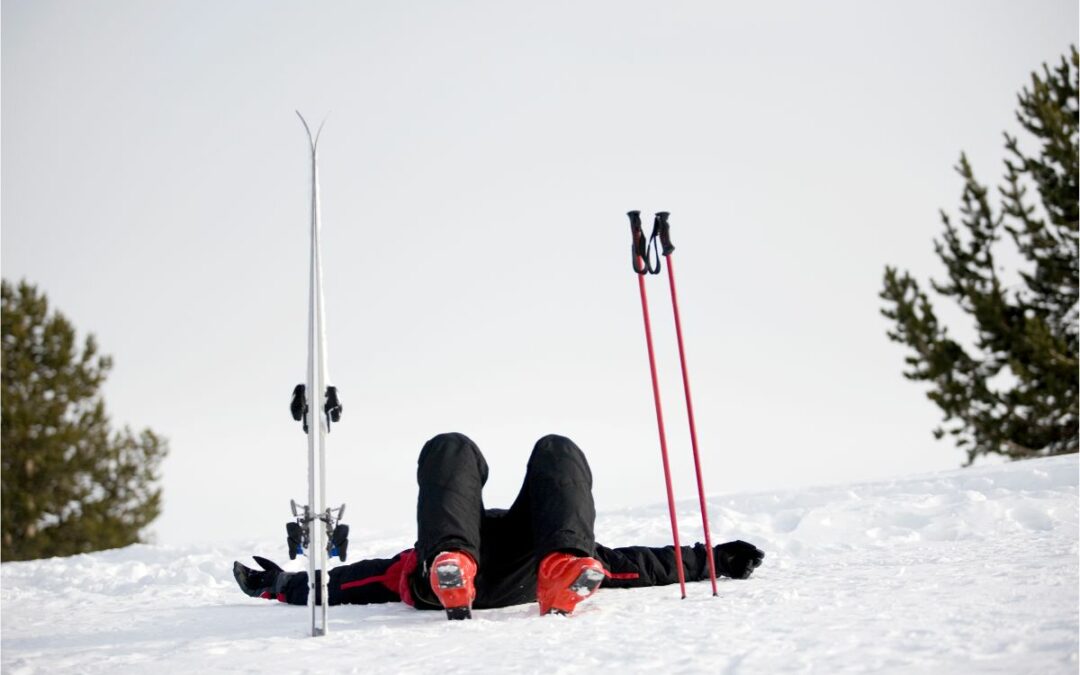Skiing can be an exhilarating activity, but there are common beginner skier mistakes you should avoid if you want to enjoy the thrills without accident and injury.
This month we examine six mistakes you might make during your first (and possibly second and third) ski season and offer practical suggestions on avoiding them.
Not Having the Right Gear
One of the most common beginner skier mistakes is using the wrong gear. Choosing suitable clothing and equipment ensures your safety and comfort while skiing.
As a beginner skier, a few essential pieces of gear will help keep you safe and comfortable on the slopes. First, invest in a quality ski jacket, pants, gloves, and a helmet.
Related: The Ultimate Guide to Choosing the Best Winter Jacket for Mountain Sports
Staying warm and comfortable on the slopes requires layering. Make sure some of your layers include wool and waterproof fabrics.
Additionally, a good pair of ski goggles and sunglasses with UV protection are essential (and remember to apply sunscreen before heading out).
Finally, since cell coverage in the mountains can be spotty in some areas, we recommend always having a whistle or other safety device with you in case of an emergency.
 Overestimating Your Ability
Overestimating Your Ability
Even for exceptional athletes, skiing may be challenging. So before you hit the slopes, take time to master the basics. This includes getting comfortable with your gear, learning to turn and stop, and understanding and using proper form.
Because skiing involves so much coordination, many beginner skiers benefit from taking lessons before hitting the slopes to get comfortable with the basics and safely learn to ski.
Underestimating Conditions and Surroundings
Another of the more common beginner skier mistakes is underestimating skiing conditions and not being aware of your surroundings in general.
Skiing can be dangerous due to icy, wet, and uneven surfaces. Beginner skiers often underestimate these conditions and take risks that can lead to falls and injuries. Pay attention to weather and terrain conditions, and watch for other skiers. Whenever possible, ski on well-groomed trails and choose trails appropriate for your skill level (more about that below).
Additionally, keep an eye out for obstacles on the slopes, like moguls and rocks. Paying attention to your surroundings will help you avoid potential collisions or falls.
Not Following Basic Safety Rules
Another of the most common beginner skier mistakes is not following basic safety guidelines. Most Colorado ski resorts have rules to ensure all skiers’ safety. Follow these rules to avoid accidents and injuries.
For example, skiing too fast, snowboarding in the wrong area, or skiing across boundaries can all increase the risk of collisions and falls. Pay attention to the signage and follow the instructions provided by ski instructors.
Not Understanding Ski Run Ratings
Another of the common beginner skier mistakes ski patrols see everyday is a rookie not paying attention to signs designed to ensure the safety of all skiers.
Colorado ski resorts rate the difficulty of their runs with these signs:
Green: These slopes are the easiest and most suitable for beginner skiers, as they are generally wide and well-groomed.
Blue: Runs with blue signs are slightly more difficult than green slopes but can still suit beginners. They may be narrower and have some moguls or steeper sections.
Black diamond: Black diamond slopes are indicated by a black diamond on top of a blue square [1]. Black diamond slopes are for advanced skiers, as they are steeper and more challenging than blue slopes.
Double black diamond: These are the most difficult ski runs, and only expert skiers should attempt to ski them. They are often narrow and steep and may have moguls and other obstacles.
Understanding these ski run ratings will help you avoid beginner skier mistakes like getting stuck on a run you are not yet ready to conquer.
Additionally, ski resorts will often have additional signs to designate areas off-limits to skiers or snowboarders or areas closed due to dangerous conditions. Paying attention to these signs will keep you on the runs you are ready for and reduce the change of injury.
Knowing When To Take a Break
If you are skiing with friends or family at a higher skill level, you may fall prey to the beginner skier mistakes of not taking breaks when needed. More advanced skiers know what to expect on the slopes, so their rookie friends may feel pressure to keep going, even when exhausted.
Getting proper rest and maintaining good winter hydration levels, especially at Colorado’s higher altitudes, will help you avoid the over-exertion that often leads to injury while learning to ski.
Additionally, stretch before your first run, at the end of the day, and whenever you break in between. Stretching helps warm the muscles, reduces the risk of injury, and improves flexibility. When skiing, the muscles can be put under a lot of strain, and stretching helps to reduce this strain, so the skier can perform better and enjoy their skiing experience more. Stretching is also crucial for safety, reducing the risk of slips and falls.
Beginner Skier Mistakes That Are Easy to Avoid: Overspending On Ski Gear
At MER, we want everyone to get out and enjoy the great outdoors, and we believe that your enjoyment of Colorado’s winter sports should not be limited because of your budget. As avid skiers ourselves, our gently-used outdoor gear consignment store in Colorado Springs carries brands we love at a fraction of the cost of new gear. From ski boots, helmets and poles to jackets, pants and gloves, we have everything you need to learn to ski.
Please stop by today to see what we currently have in stock. We look forward to outfitting you for your adventures!

